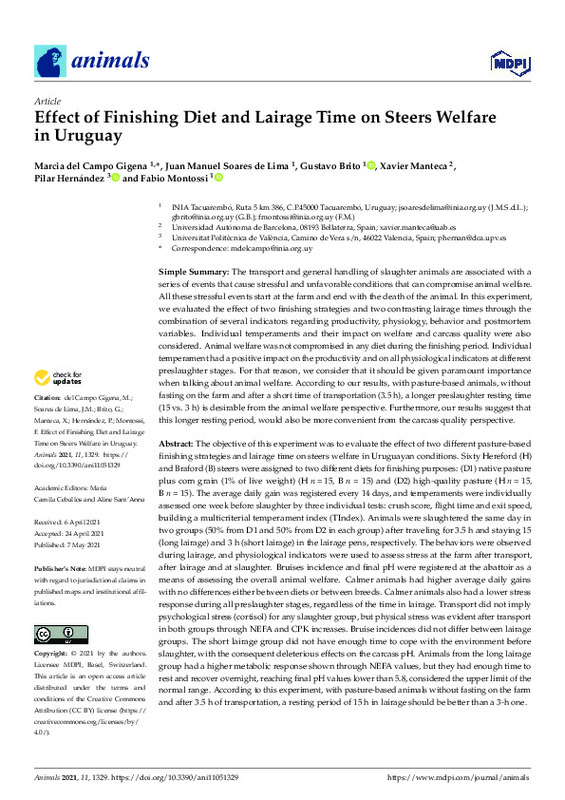JavaScript is disabled for your browser. Some features of this site may not work without it.
Buscar en RiuNet
Listar
Mi cuenta
Estadísticas
Ayuda RiuNet
Admin. UPV
Effect of Finishing Diet and Lairage Time on Steers Welfare in Uruguay
Mostrar el registro sencillo del ítem
Ficheros en el ítem
| dc.contributor.author | del Campo Gigena, Marcia
|
es_ES |
| dc.contributor.author | Soares de Lima, Juan Manuel
|
es_ES |
| dc.contributor.author | Brito, Gustavo
|
es_ES |
| dc.contributor.author | Manteca, Xavier
|
es_ES |
| dc.contributor.author | Hernández, Pilar
|
es_ES |
| dc.contributor.author | Montossi, Fabio
|
es_ES |
| dc.date.accessioned | 2022-05-30T18:04:56Z | |
| dc.date.available | 2022-05-30T18:04:56Z | |
| dc.date.issued | 2021-05 | es_ES |
| dc.identifier.uri | http://hdl.handle.net/10251/182984 | |
| dc.description.abstract | [EN] The transport and general handling of slaughter animals are associated with a series of events that cause stressful and unfavorable conditions that can compromise animal welfare. All these stressful events start at the farm and end with the death of the animal. In this experiment, we evaluated the effect of two finishing strategies and two contrasting lairage times through the combination of several indicators regarding productivity, physiology, behavior and postmortem variables. Individual temperaments and their impact on welfare and carcass quality were also considered. Animal welfare was not compromised in any diet during the finishing period. Individual temperament had a positive impact on the productivity and on all physiological indicators at different preslaughter stages. For that reason, we consider that it should be given paramount importance when talking about animal welfare. According to our results, with pasture-based animals, without fasting on the farm and after a short time of transportation (3.5 h), a longer preslaughter resting time (15 vs. 3 h) is desirable from the animal welfare perspective. Furthermore, our results suggest that this longer resting period, would also be more convenient from the carcass quality perspective. The objective of this experiment was to evaluate the effect of two different pasture-based finishing strategies and lairage time on steers welfare in Uruguayan conditions. Sixty Hereford (H) and Braford (B) steers were assigned to two different diets for finishing purposes: (D1) native pasture plus corn grain (1% of live weight) (H n = 15, B n = 15) and (D2) high-quality pasture (H n = 15, B n = 15). The average daily gain was registered every 14 days, and temperaments were individually assessed one week before slaughter by three individual tests: crush score, flight time and exit speed, building a multicriterial temperament index (TIndex). Animals were slaughtered the same day in two groups (50% from D1 and 50% from D2 in each group) after traveling for 3.5 h and staying 15 (long lairage) and 3 h (short lairage) in the lairage pens, respectively. The behaviors were observed during lairage, and physiological indicators were used to assess stress at the farm after transport, after lairage and at slaughter. Bruises incidence and final pH were registered at the abattoir as a means of assessing the overall animal welfare. Calmer animals had higher average daily gains with no differences either between diets or between breeds. Calmer animals also had a lower stress response during all preslaughter stages, regardless of the time in lairage. Transport did not imply psychological stress (cortisol) for any slaughter group, but physical stress was evident after transport in both groups through NEFA and CPK increases. Bruise incidences did not differ between lairage groups. The short lairage group did not have enough time to cope with the environment before slaughter, with the consequent deleterious effects on the carcass pH. Animals from the long lairage group had a higher metabolic response shown through NEFA values, but they had enough time to rest and recover overnight, reaching final pH values lower than 5.8, considered the upper limit of the normal range. According to this experiment, with pasture-based animals without fasting on the farm and after 3.5 h of transportation, a resting period of 15 h in lairage should be better than a 3-h one. | es_ES |
| dc.description.sponsorship | This research was financed by INIA Uruguay and received no external funding. | es_ES |
| dc.language | Inglés | es_ES |
| dc.publisher | MDPI AG | es_ES |
| dc.relation.ispartof | Animals | es_ES |
| dc.rights | Reconocimiento (by) | es_ES |
| dc.subject | Stress response | es_ES |
| dc.subject | Transport in cattle | es_ES |
| dc.subject | Lairage time | es_ES |
| dc.subject | Temperament | es_ES |
| dc.subject.classification | PRODUCCION ANIMAL | es_ES |
| dc.title | Effect of Finishing Diet and Lairage Time on Steers Welfare in Uruguay | es_ES |
| dc.type | Artículo | es_ES |
| dc.identifier.doi | 10.3390/ani11051329 | es_ES |
| dc.rights.accessRights | Abierto | es_ES |
| dc.contributor.affiliation | Universitat Politècnica de València. Departamento de Ciencia Animal - Departament de Ciència Animal | es_ES |
| dc.description.bibliographicCitation | Del Campo Gigena, M.; Soares De Lima, JM.; Brito, G.; Manteca, X.; Hernández, P.; Montossi, F. (2021). Effect of Finishing Diet and Lairage Time on Steers Welfare in Uruguay. Animals. 11(5):1-19. https://doi.org/10.3390/ani11051329 | es_ES |
| dc.description.accrualMethod | S | es_ES |
| dc.relation.publisherversion | https://doi.org/10.3390/ani11051329 | es_ES |
| dc.description.upvformatpinicio | 1 | es_ES |
| dc.description.upvformatpfin | 19 | es_ES |
| dc.type.version | info:eu-repo/semantics/publishedVersion | es_ES |
| dc.description.volume | 11 | es_ES |
| dc.description.issue | 5 | es_ES |
| dc.identifier.eissn | 2076-2615 | es_ES |
| dc.identifier.pmid | 34066914 | es_ES |
| dc.identifier.pmcid | PMC8148579 | es_ES |
| dc.relation.pasarela | S\448784 | es_ES |
| dc.contributor.funder | Instituto Nacional de Investigación Agropecuaria, Uruguay | es_ES |








